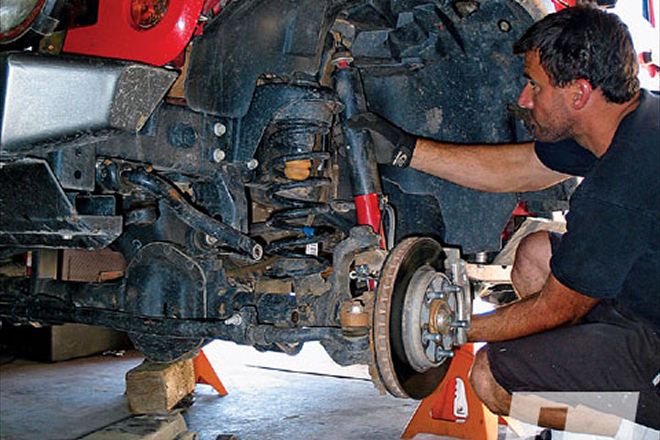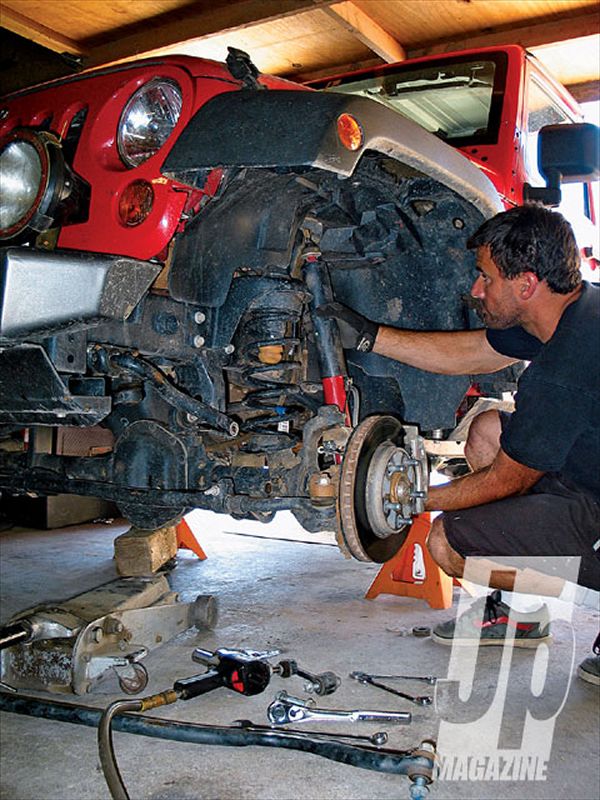
 John Cappa
Former Editor, Four Wheeler
John Cappa
Former Editor, Four Wheeler
 Dust off all your odd-ball metric wrenches and sockets. The JK has lots of 19mm, 18mm, and 16mm suspension hardware. With the Jeep's frame safely sitting on jackstands you can begin disassembly. Loosen all suspension link and track bar hardware as well.
Dust off all your odd-ball metric wrenches and sockets. The JK has lots of 19mm, 18mm, and 16mm suspension hardware. With the Jeep's frame safely sitting on jackstands you can begin disassembly. Loosen all suspension link and track bar hardware as well.
Thanks to larger wheelwells and better suspension geometry, it's not difficult to fit up to 35-inch tires on your '07-'09 Wrangler. The needed 3 inches of lift can be installed in a weekend by one person in a garage or driveway with common handtools, and even quicker if you have a competent helper that isn't too busy drinking all of your beer. Based on its simplicity and performance we selected the Black Diamond 3-inch lift with optional lower control arms and mono-tube shocks. This relatively inexpensive kit provides equal or better performance than many kits that cost several times as much. Very detailed instructions are included with the lift kit, so here are some of our tips and tricks to make your install go smoother.
How's It Work?
In the beginning we were extremely reluctant to change the awesome original suspension of our Wrangler. Overall, we've been really happy with the soft controlled ride of the 3-inch Black Diamond lift kit and Superide Select monotube shocks by Bilstein. The kit clears the 35-inch tires easily and performs well at high and low speeds. At full articulation we do have some slight rubbing on the pinch seams just in front of the rear tires. But it's nothing a small bit of trimming can't cure. On the road there is zero drivetrain vibration, zero bumpsteer, and the ESP stability control system still works flawlessly with the lift and bigger tires. No alignment was required; however we needed to adjust the drag link to center the steering wheel. For us, the factory 4.10 gears and 35-inch tire combo works out pretty well with the manual transmission. The engine revs less at high speeds now and we can pull most grades in Fifth gear. Sixth has become kind of a deep overdrive. Only occasionally do we need to drop to Fourth gear on grades with strong headwinds. At this point we have no plans to swap out the ring and pinions for more seat of the pants power. It's just not really needed. The lift and tires did hurt fuel mileage, though. The added wind and rolling resistance has caused our fuel economy to drop a little more than 1 mpg. We've gone from an on- and off-road average of 15.9 mpg stock, to 14.6 mpg with the lift and tires. If fuel economy becomes more of a concern in the future we may consider dropping the Jeep an inch and swap to some 33-34-ish sized tires. But driving less aggressively would make a bigger difference in fuel economy.
















